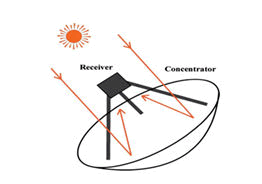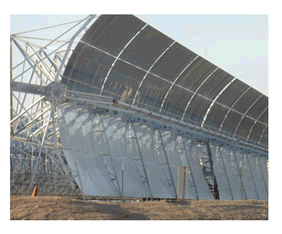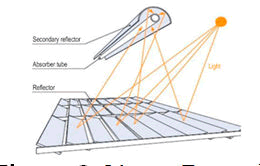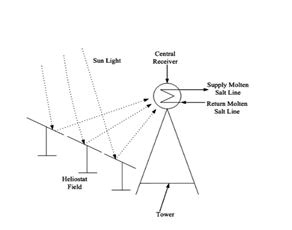Research Article, J Nucl Ene Sci Power Generat Technol Vol: 11 Issue: 4
Solar Energy in Concentrating Collectors: A Study
Prasanna Mishra1*, Ravinder Pal Singh2, Manoj Gupta3 and Monika Deshwal4
1Department of Automoblie Electronics and Communication Engineering, PSG collage, Bengaluru, India
2Department of Mechanical Engineering, RIMT University, Mandi Gobindgarh,Punjab, India
3Department of Mechanical Engineering, SOEITSanskriti University, Mathura,Uttar Pradesh, India
4Department of Mechanical Engineering, SGT University, Gurugram, Haryana
*Corresponding Author :Prasanna Mishra, Department of Automoblie Electronics and Communication Engineering, PSG collage, Bengaluru, India, E-mail:prasannamishra234@gmail.com
Received date: 03 November, 2021, Manuscript No. JNPGT-22-46548;
Editor assigned date: 05 November, 2021, PreQC No. JNPGT-22-46548 (PQ);
Reviewed date: 19 November, 2021, QC No. JNPGT-22-46548;
Revised date: 03 January 2022, Manuscript No. JNPGT-22-46548 (R);
Published date: 23 March 2022, DOI: 10.4172/2325-9809.1000263
Citation: Prasanna M, Ravinder PS, Manoj G, Monika D (2022) Solar Energy in Concentrating Collectors: A Study. J Nucl Ene Sci Power Generat Technol 11:4.
Abstract
Sunlight based energy assumes a fundamental part in the climate. This sustainable power assists with giving energy arrangements. There are various types of collectors dependent on stationary collectors and concentrating collectors. Basically collectors are used to gather the fuel source from the sun. Solar collector change solar energy into heat, which is then transferred to a fluid media. Sun produces heat energy which is collected by the different collectors for different purposes. This presents a study of solar energy in concentrating collectors. This paper discussed the various concentrating collectors such as heliostat field collectors, parabolic trough collectors, parabolic dish reflector, as well as linear Fresnel reflector. The concentrating collector helps to use the lenses and mirrors to concentrate the heat energy optically, before transferring it into heat. In future this examination assists with finding out about the concentrating gatherers and empowers the concentrating sun based force plants to deliver the power 24 hours in a day.
Keywords: Sun light, Solar, Heat, Power, Parabolic reflector, Fresnel, Energy
Introduction
In this current time, everybody needs the power in their day by day needs, since most extreme gadgets are turning into an electrical gadget to make those gadgets more proficient in their work; they need some wellspring of energy to work. There are two kinds of wellspring of energy, for example, there are two kinds of energy sources such as Renewable or Sustainable sources of energy and non-renewable or non-sustainable sources. Wind energy, solar energy, as well as biogas energy is the examples of sustainable energy resource. Coal, petroleum, gas and other fuels are examples of non-sustainable resources [1]. Solar energy is a renewable source of energy which is always available in the day time. Enormous amounts of energy are generated by the sun called as solar energy. It is basically utilized to generate the heat and electricity. There are different applications, such as generation of central power, air conditioning and huge requirements of industrial heat. Carrier fluids cannot provide the sufficient temperature which can be provided by the Flat plate collectors. The concentrating collectors can be utilized to reflect and focus incident energy onto small receiving areas that move and track the sun on the off chance that they are to perform viably. Renewable resources are sources that, in a finite amount of time on a human time frame, will replenish the amounts lost by use and use, either via regular generation or through restorative methods. A portion of Earth's native ecosystem and the largest portions of its ecosphere are inexhaustible resources.
Materials and Methods
A positive life cycle analysis is a key indicator of an asset's viability. Geothermal energy, biomass energy, water energy, Wind energy, flowing energy, and solar arranged energy are all examples of maintainable force. Sun oriented fueled energy is the sort of intensity which is put away by the daylight energy [2]. It tends to be used in two different ways either by indirectly concentrated solar power, directly used photovoltaic. Sunlight based energy is the warmth type of the sun. Individuals can control the energy of the sun to deliver the power to accomplish something. Sun based energy has experienced uncommon improvement starting late in light of both inventive Improvements achieving cost diminishes and government plans solid of environmentally friendly power progression and use. The expense of sun oriented energy has declined rapidly in the progressing past; it really remains much higher than the cost of normal energy propels. As well as other ecologically friendly energy breakthroughs rebuilding the force's area has had a profound impact on the standard mission and utility requirements, as well as on the country's normal, social, and political situations. Simultaneously, new regulatory concepts for reducing environmental effects in the modified force zone are being developed. As a result, there are several types of sun-based collectors.
Result and Discussion
Types of collectors
There are two types of solar collectors such as concentrating collectors and stationary collectors. But in this paper, basically focused on the concentrating collectors.
Concentrating collectors
Concentrating collectors are the type of collectors which are utilized on focal points or mirrors to focus the solar powered energy optically prior to moving into the heat, in which fixation can be accomplished by one or the other refraction or reflection. Concentrating on authorities with high fixation proportions, they require a global positioning framework to track the sun along these lines. There are various kinds of concentrating authorities, for example, allegorical dish reflector, illustrative box gatherer, straight Fresnel reflector and heliostat field gatherer. It is coordinating and thinking sunlight based energy authorities with a concentrating reflector [3].
Parabolic dish reflector
As per the name the parabolic reflector antenna is in parabola shape. Parabolic dish reflector is a highly utilized dish antenna. It reflects the signal to the dish focal point [4]. This reflector is a double axis tracker as shown in Figure 1 [4]. The allegorical dish authority or concave dish gatherer is fully coordinated toward the receiver. It's a point center kind, which means the safeguard is a water compartment. To increase the absorption of sun-powered energy, the observer of water is painted functioning at a profit dark. It converts the sun's energy into warm energy, which it then delivers into the flowing liquids [5]. It has a higher level of competence than other gatherers since it always highlights the sun. The explanation dish framework does not have the capacity for storing, however it may be combined with other frameworks to function when there is no daylight.

Figure 1: The parabolic dish reflector. It is flexible and double axis in nature. It helps to transmit the circulating fluids.
Parabolic trough collector
So far, we've seen a number of solar collector designs that heat water using the sun's energy. Each design, whether it's a basic blackened flat panel collector or a more complicated evacuated tube collector, has its own set of benefits and drawbacks, and these types of solar collectors are more than enough for most residential solar hot water systems [6]. This is created by bending a sheet of reflective material into a parabolic form, as seen in Figure 2. A metal black coated cylinders is inserted to the beneficiary's central line. The reflectors reflect sun-oriented radiation to the recipient cylinder when it strikes the parabola that is aligned with the sun. Regardless, the reflected light must pass through the glass cover and be emptied. The allegorical box authorities insist on a single sun-following hub. The gatherer may be set up in an east west orientation to follow the sun from the north to south, or it can be set up in a north-south orientation to observe the sun from east to west. Summer or winter, the choice of direction is based on the application and amount of energy needed. The condition of concentrating sun-based authority must be specifically designed such that all incoming daylight reflects off the exterior of the gatherer and appears at a same location of convergence, regardless of which portion of the gatherer is struck first [7].

Figure 2: The parabolic trough collector. This parabolic trough collector is designed like a parabola. Which may focus the sun at 30 – 100 times the collector's usual intensity.

Figure 3: Linear Fresnel reflector device it focuses solar beam energy into an absorber tube positioned at the Fresnel's mirror's central focus.
A Linear Fresnel Reflector is another sort of sun oriented force authority. It utilizes level mirrors instead of illustrative mirrors that are utilized in sun based allegorical boxes as shown in Figure 3 [8]. The fundamental rule stays as before with the mirrors gathering sunlight based force which is then used to produce steam which thus drives a turbine. This innovation prompts the creation of steam straightforwardly and doesn't utilize heat, move liquid or other medium. The daylight that is concentrated with the assistance of mirrors heats up the water which is available in the beneficiary cylinders consequently creating steam. This design does not have any heat exchangers. A straight Fresnel reflector is made up of a group of direct mirror strips that work together to concentrate light on a collector placed on the pinnacle's highest point. While the sun is tracked by the mirror, the receiver is fixed. Two tough steel safeguard tubes confine the circular liquids in the receiver. Sun oriented energy will be changed over into heat energy and sent to the liquid which will be utilized in electric warm application or application that needs high temperatures [9]. An auxiliary reflector would be a CPC which mirrors the approaching reflected beams from the mirror precisely to the recipient. Level mirrors are utilized which are less expensive and that more reflectors can be put in a similar measure of room, this permits more proficient usage of the daylight accessible.
Heliostat field collector
Heliostat field gatherer employs heliostat fields, which are different types of organizer reflectors, to obtain full 3D focus and high fixation proportions [9]. Two tomahawks are needed for each mirror to follow the sun and beam light on the receiver, who is situated on the highest point of the sun-oriented pinnacle [10]. The heliostat reflects the incoming light from the sun straightforwardly to a one goal where the focal benefit is reducing the energy transfer which will lead for energy disasters, may arrive at a focus proportion and store the warm energy as shown in Figure 4. As other framework heliostats reflect and gather the sunrays to the recipient which changes the sun based energy over to warm energy communicated to the circling liquid can either go to capacity or put away as reasonable warmth for some time in the future or straightforwardly to the force protection framework. Focal collector framework is viewed as a more effective framework than the allegorical box framework. It tends to be handily hybridized with non-renewable energy source frameworks when there are no enough sunlight based beams.

Figure 4: Shows the heliostat field collector. It is utilized in the solar power plant. Sometime multiple heliostats can concentrate sunlight onto a single target.
Applications of solar concentrating energy
Concentrating sun oriented force can be used to create the electric momentum by changing energy from daylight over to control a turbine, yet it very well may be used as warmth in an assortment of modern applications, similar to water desalination, food handling, substance creation, mineral preparing and improved oil recuperation. There are different viable applications where the concentrating sunlight based force is used. Cooling and chilling may be utilized for the food refrigeration. This cooling cycle will maintain up the temperature about 4 to 7°C. In several regions of the globe comprising India as well as the great popular of sub-Saharan Africa, It is the real unique benefits. Heating water may be warmed for one or the other homegrown or institutional purpose for usage set up such quarters and emergency clinic. This may involve heating water for cooking, washing, and cleaning, to name a few examples. While this is perhaps the most obvious use, it seems to be one of the most common, and the investment funds are simple to choose. The expense of warming the water cycle with an alternative fuel source. Industrial measure: To clean mechanical gear and equipment, hot water may be utilized. Some industries, such as refreshment packing plants, need a huge amount of boiling water for both production and support.
A pressurized heat exchanger that allows the water to reach temperatures over 100 degrees Celsius may also be used to generate steam. The reserve monies are once again avoiding the expense of warming the water or steam. Space chilling as well as heating energy may be used for space warming in homes, production lines, quarters, and emergency clinics, among other places, or ingesting chillers can offer cooling in the same way. In rural applications, heating around evening time as well as chilling during the day to maintain a constant temperature may improve nursery plants and yields. Furthermore, CO2 generated by the combustion of biogas or other fuel to generate power during the nighttime hours may be ducted to the nurseries to aid plant growth. As the temperature rises, so does the efficiency of biogas production. Additional heating may be used to speed up the absorption tank's waste-to-fuel conversion cycle. This is necessary because biogas may immediately transform into a source of sustainable electricity or heat, or it can be managed to provide an unending supply of fuel. Why produce more electricity since more electricity is required and there are no uses for the heated energy for heating and cooling. A rankine cycle turbine that can produce power from low-temperature heat. It is often used to increase the overall solar-powered system's force yield.
Disadvantage and advantage of solar energy
Using mirrors or lenses, Concentrated Solar Power (CSP) systems concentrate a large amount of sunlight, or solar thermal energy, onto a small area. When concentrated light is converted to heat, electricity is generated, which is used to power a heat engine (usually a steam turbine) or a thermochemical process. The disadvantage is that solar thermal plants create a lot of waste heat that may be utilised to purify waste water and turn it into fresh water.
Pros
- Carbon free
- Can fill in as a drop-in swap for traditional powers to make steam
- High effectiveness
- Renewable energy
- Operating costs are low
Cons
- Manufacturing measures frequently make contamination
- Heavily area subordinate
- Intermittent
- Low energy thickness
- Construction/establishment costs are high
- They require a lot of room
- Will include critical transmission distances/misfortunes.
Conclusion
Sun based energy advancements have become established and popular technologies all over the globe. To achieve this, billions of US dollars have been donated and significantly more are counted upon to invest resources into the not so distant future to overcome the present limitations in the solar powered sector. By and by, different new huge scopes sunshine based forces (for instance CSP) enterprises are coming on the web or are a work in progress in both produced and agricultural countries. CSP has been found to be acceptable for regions without continuous mists or murkiness, in spite of the way that the framework is more expensive than PV innovation. PV advancements for the moment may carry on being the main wellspring of sunshine based power age. Also, the anticipated market for off-network celestial bodies remains largely unknown given the limited development of supporting methods and foundations. In spite of a rapid reduction in sun based innovation prices recently, the general expenditures to generate sunlight based force really remain substantial.
Impetuses and discounts which are essential for the development of the sun focused energy industry are making it clear that innovative methods are as still necessary to lower the monetary weight of other strategy motivating factors. In any event, the sun focused industry should be zero in addition to the quality and development of its invention. Furthermore, analysts need to also concentrate in on increasing the intensity of sunshine based force versus both conventional and alternative environmentally friendly power sources. Ideally, additional exploration efforts will be dedicated toward PV advances shortly to increase their effectiveness, stability, manufacturability, and accessibility, to decrease Balance-Of-Framework (BOS) prices and diminish the charges of modules. In this study, we examined the global capacity of sun based energy breakthroughs, their limitations and advantages, and their future potential. Appropriately, we inferred that despite of a couple of drawbacks sun based energy innovation is one of the most promising environmentally pleasant power sources to satisfy the future global energy interest.
References
- Prasad S, Sheetal KR, Venkatramanan V, Kumar S, Kannojia S, et al. (2019) Sustainable energy: challenges and perspectives. Sustain Green TechnolEnviron Manag 175-197.
- “Non-Renewable Energy Resources,” the geological society, serving science, profession and society.
- Mjachina KV, Baynard CW, Chibilyev AA, Richardson RD (2018) Landscape disturbance caused by non-renewable energy production in a semi-arid region: A case study on the Russian steppe. Int J Sustain Develop World Ecol 25: 541-553.
- Malviya G, Panda DK. Review paper on Efficiency Improvement in the Parabolic Reflector Dish Antenna System.
- Montes IE, Benitez AM, Chavez OM, Herrera AE (2014) Design and construction of a parabolic trough solar collector for process heat production. Energy Procedia. 57: 2149-2158.
- Collado FJ, Guallar J (2017) Improved heliostat field design for solar tower plants. AIP Conference Proceedings. AIP Publishing LLC.
- Collado FJ, Guallar J (2019) Quick design of regular heliostat fields for commercial solar tower power plants. Energy 178:115-25.
- Khullar V, Tyagi H, Phelan PE, Otanicar TP, Singh H, et al. (2012) Solar energy harvesting using nanofluids-based concentrating solar collector. J Nanotechnol Eng Med 3.
- Al-Aboosi FY (2020) Models and hierarchical methodologies for evaluating solar energy availability under different sky conditions toward enhancing concentrating solar collectors use: Texas as a case study. Int J Energy Environ Eng 11:177-205.
- Tyagi SK, Wang S, Singhal MK, Kaushik SC, Park SR, et al. (2007) Exergy analysis and parametric study of concentrating type solar collectors. Int J Thermal Sci 46:1304-1310.
 Spanish
Spanish  Chinese
Chinese  Russian
Russian  German
German  French
French  Japanese
Japanese  Portuguese
Portuguese  Hindi
Hindi 

